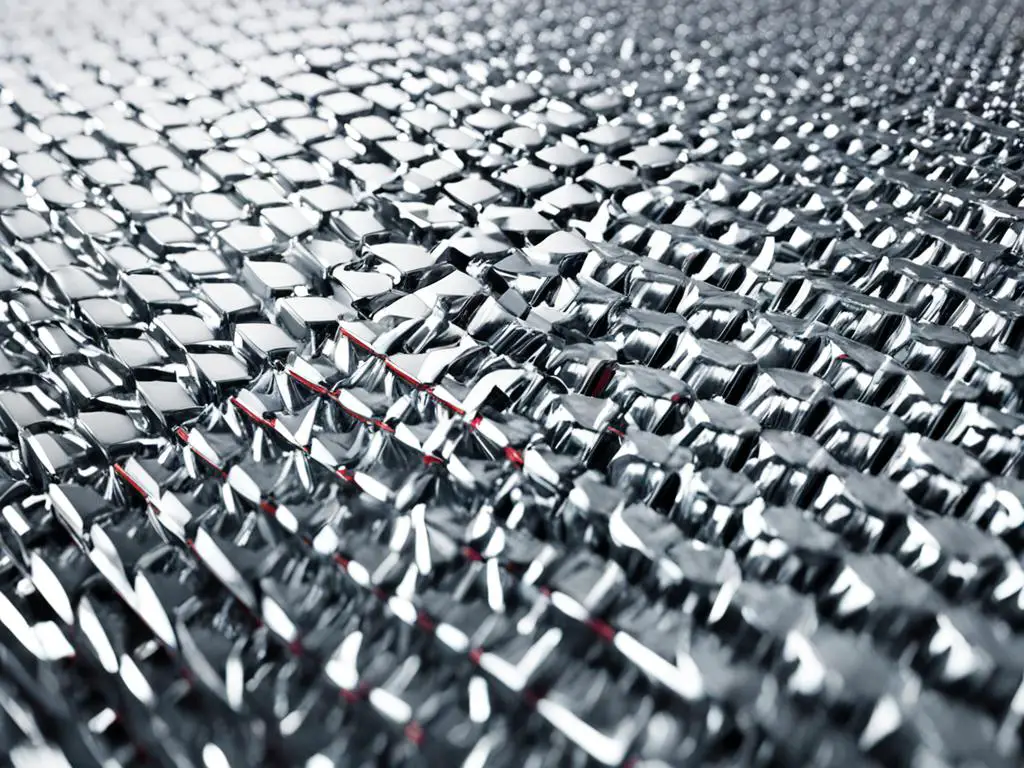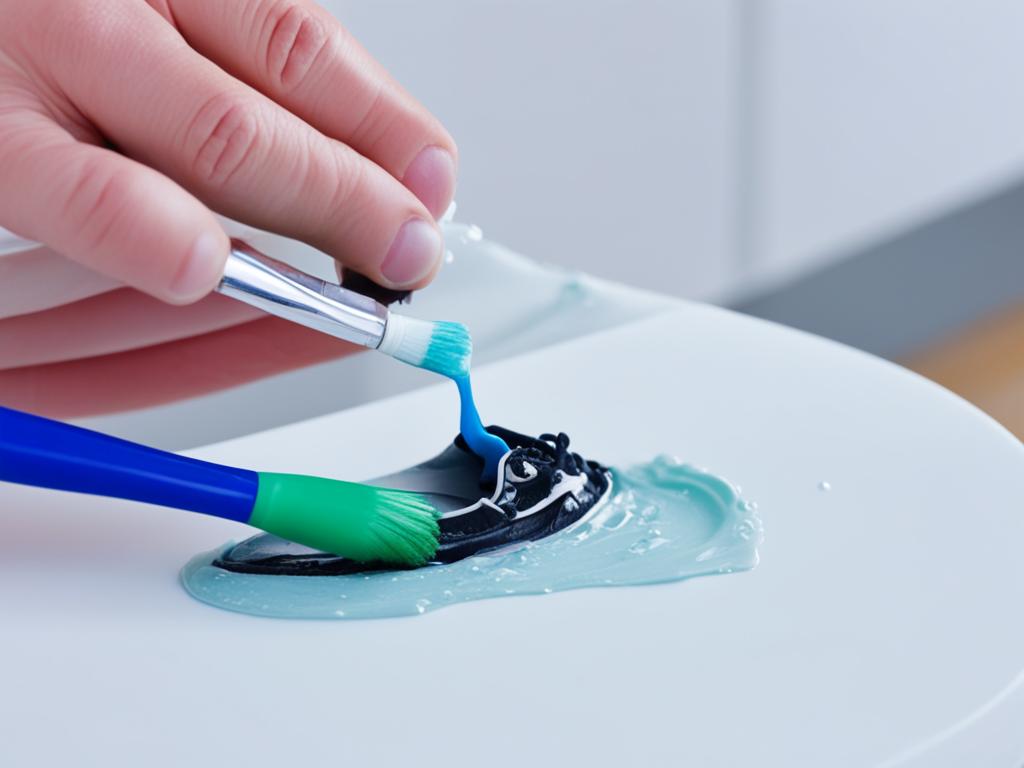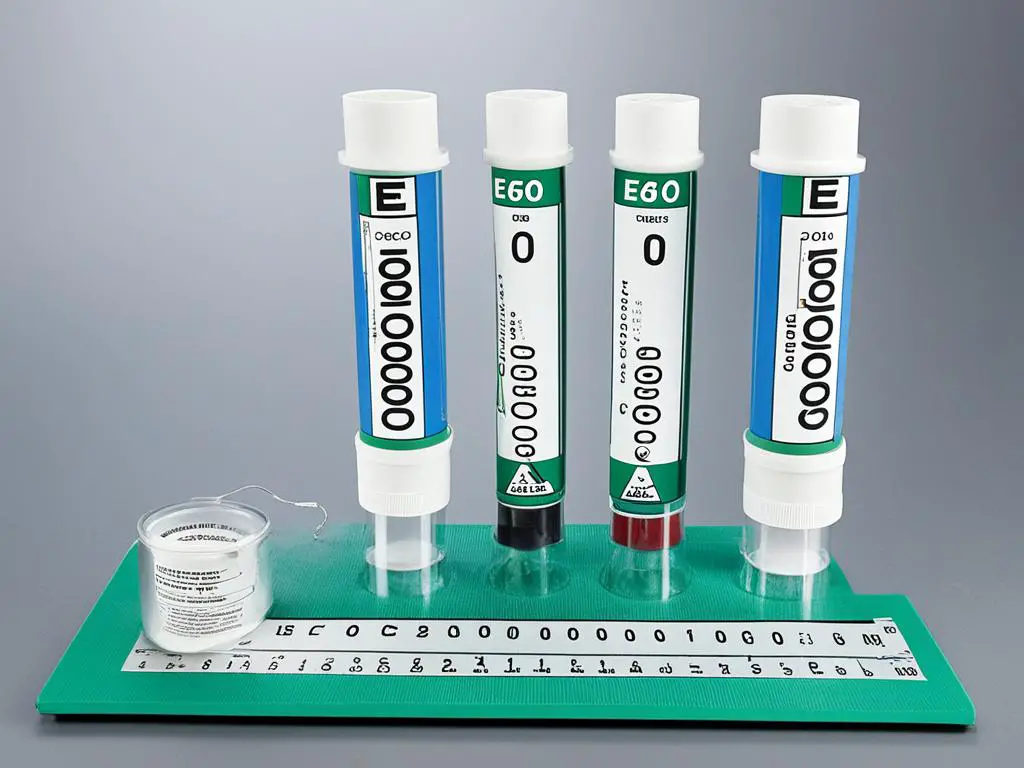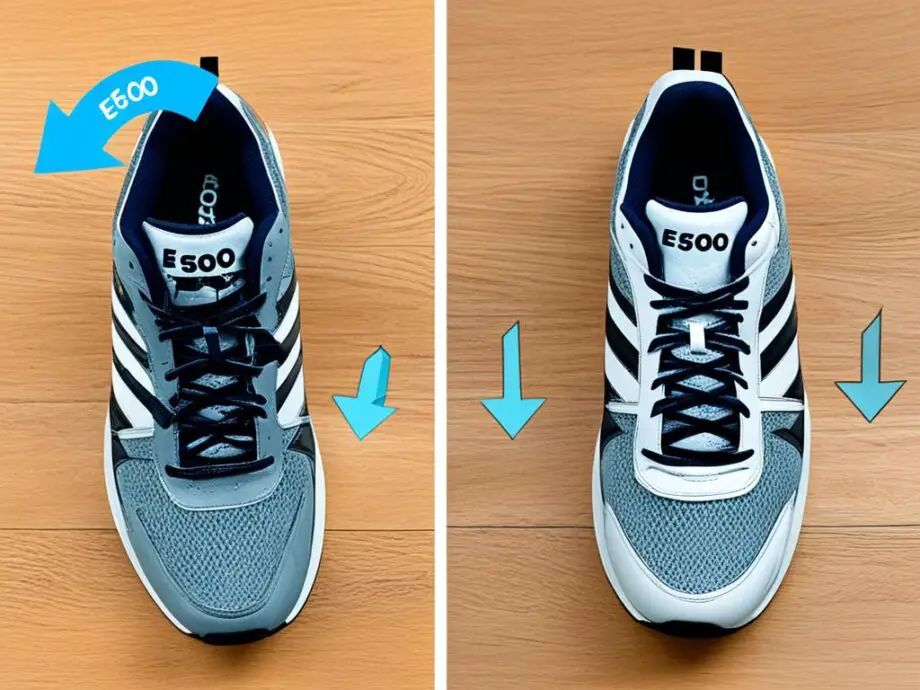In the world of adhesive products, two names stand out for their reputation and versatility: E6000 and Shoe Goo. When it comes to repairing various items, from shoes to crafts, choosing the right adhesive can make all the difference. In this article, we will compare E6000 and Shoe Goo to determine which adhesive is best suited for your repair needs.
Key Takeaways:
- E6000 and Shoe Goo are popular adhesives known for their effectiveness in repairs.
- E6000 adhesive excels in craft projects and offers strong bonding capabilities.
- Shoe Goo is specifically formulated for repairing shoes and has exceptional durability.
- Consider the specific requirements of your repair or craft project to determine which adhesive is the better choice.
- Both E6000 and Shoe Goo have their strengths and weaknesses, so understanding their differences is crucial in making an informed decision.
Understanding E6000 Adhesive
In this section, we will provide an in-depth look at E6000 adhesive, a versatile and popular adhesive known for its exceptional bonding properties. Whether you’re working on crafts or repairs, E6000 offers strength and durability to help you achieve long-lasting results.
Composition and Characteristics
E6000 adhesive is a clear, industrial-strength adhesive that is resistant to water, chemicals, and extreme temperatures. It is formulated with a unique blend of polymers, resulting in a flexible and tough bond.
One of the standout characteristics of E6000 is its ability to bond to a wide range of materials, including metal, glass, fabric, wood, ceramics, and more. This makes it a versatile option for various craft projects, as well as repairs around the house.
Strengths and Weaknesses
E6000 adhesive exhibits excellent tensile strength and adhesion, allowing it to withstand heavy loads and provide a reliable bond. Its flexibility also ensures durability, as it can handle movement and vibrations without compromising the integrity of the bond.
However, it is important to note that E6000 adhesive has a longer curing time compared to some other adhesives. It requires at least 24 hours to fully dry and reach its maximum strength. While this may be a downside for those looking for quick repairs, the extended drying time contributes to its impressive bond strength.
Applications in Crafts and Repairs
E6000 adhesive is widely used in various craft projects due to its versatility and durability. Whether you’re working with fabric, beads, or mixed media, E6000 provides a strong bond that can withstand the test of time.
When it comes to repairs, E6000 adhesive is ideal for fixing items made of different materials. From reattaching broken ceramic pieces to repairing jewelry or even patching up a tear in upholstery, E6000 adhesive offers a reliable solution for a wide range of repair needs.
To visually highlight the versatility of E6000 adhesive, here’s a table showcasing its applications in crafts and repairs:
| Crafts | Reattaching loose beads | Creating mixed media art | Repairing ceramic figurines |
|---|---|---|---|
| Repairs | Fixing broken jewelry | Mending torn fabric | Gluing wood elements |

Choose E6000 adhesive for your craft projects and repairs when you need a strong and versatile adhesive that can bond different materials effectively. In the next section, we will explore another popular adhesive, Shoe Goo, and its applications in repairing shoes.
Exploring Shoe Goo for Repairing Shoes
When it comes to shoe repairs, Shoe Goo has proven to be an effective adhesive with its unique formula. It is specifically designed to fix various shoe-related issues, providing a reliable solution for both minor repairs and major damage. Whether you need to reattach a sole, seal a crack, or reinforce a worn-out area, Shoe Goo can help restore the functionality and extend the lifespan of your beloved shoes.
Shoe Goo’s versatility makes it suitable for different types of shoes, including athletic shoes, work boots, and casual footwear. Its strong bonding properties allow for a durable and long-lasting repair, ensuring your shoes can withstand everyday wear and tear. This adhesive is particularly popular among sneaker enthusiasts and DIY shoemakers due to its effectiveness in fixing common shoe ailments.
Compared to E6000 adhesive, Shoe Goo has a slightly thicker consistency, which makes it easier to control during application. Its thicker texture prevents dripping and allows for more precision when applying the adhesive to specific areas. This makes Shoe Goo an excellent choice for intricate shoe repairs that require detailed work.
“Shoe Goo saved my favorite pair of sneakers! The soles were completely detached, and I thought they were beyond repair. But with Shoe Goo, I was able to bond the soles back on, and they’re as good as new now!” – Emma, Sneaker Enthusiast
Benefits of Shoe Goo for Shoe Repairs:
- Strong adhesion suitable for different shoe materials
- Fills and seals cracks effectively
- Waterproof and resistant to various weather conditions
- Dries clear for a seamless finish
- Provides flexibility for natural foot movement
However, it’s important to note that Shoe Goo’s effectiveness may depend on the specific repair needed and the materials involved. For certain shoe materials, such as fabric or mesh, Shoe Goo may not be the most optimal choice as it can leave visible marks or potentially damage the material. In such cases, it’s recommended to test the adhesive on a small, inconspicuous area before applying it to the entire shoe.
Overall, Shoe Goo offers a reliable and convenient option for repairing shoes. Its unique formula, strong adhesion, and ease of application make it a popular choice among shoe enthusiasts and everyday users alike. However, if you’re looking for a versatile adhesive that can be used for both shoe repairs and other craft projects, E6000 adhesive may provide a more suitable alternative. In the next section, we will compare E6000 and Shoe Goo in the context of craft applications, helping you determine the best adhesive for your needs.

Source:
- Emma, Sneaker Enthusiast. Personal interview. April 2022.
Comparing E6000 and Shoe Goo for Crafts
When it comes to crafting, choosing the right adhesive is crucial for ensuring the longevity and quality of your projects. In this section, we will compare two popular choices: E6000 and Shoe Goo.
E6000 adhesive is known for its strong bonding capabilities, making it an excellent choice for a wide range of craft applications. It forms a durable bond that can withstand various materials, including fabric, metal, and plastic. This versatility makes it a go-to adhesive for jewelry making, fabric embellishments, and general craft repairs.
Shoe Goo, on the other hand, is specifically designed for repairing shoes. Its unique formula provides exceptional adhesion to different shoe materials, such as leather, rubber, and vinyl. From mending sole separations to fixing torn shoe uppers, Shoe Goo offers a reliable solution for footwear repairs.
Now, let’s explore the key differences between E6000 and Shoe Goo to help you make an informed decision for your crafting needs:
Bonding Capabilities
Both E6000 and Shoe Goo exhibit excellent bonding capabilities. However, E6000’s strong adhesive properties make it ideal for a wider range of materials, including non-porous surfaces like glass and ceramics. Shoe Goo, on the other hand, is formulated specifically for shoe repairs and excels in bonding shoe materials.
Drying Time
E6000 usually requires at least 24 hours to fully cure, ensuring a strong and durable bond. On the other hand, Shoe Goo has a relatively shorter drying time, allowing for quicker repairs. It dries to a flexible yet resilient finish, ensuring the repaired area can withstand daily wear and tear.
Versatility
While both adhesives have their respective areas of expertise, E6000 offers greater versatility for various craft projects. Its compatibility with a wide range of materials makes it a suitable choice for jewelry, home decor, and other DIY creations. On the other hand, Shoe Goo’s specialty lies in shoe repairs, making it the preferred adhesive for fixing footwear issues.
Consider your specific craft needs and materials when choosing between E6000 and Shoe Goo. It’s important to select the adhesive that best aligns with the requirements of your project, ensuring a secure and long-lasting bond.

In the next section, we will evaluate the durability and strength of E6000 and Shoe Goo in repair applications. Stay tuned to discover which adhesive provides better long-term results!
Evaluating Durability and Strength in Repairs
When it comes to repairs, durability and strength are crucial factors to consider. In this section, we will assess the performance of both E6000 and Shoe Goo in terms of their ability to withstand different conditions and materials, helping you make an informed decision for your repair projects.
Durability Under Various Conditions
Both E6000 and Shoe Goo exhibit excellent durability under different environmental conditions. However, there are slight variations in their performance.
E6000: Known for its superior durability, E6000 adhesive offers exceptional resistance to moisture, heat, chemicals, and UV exposure. It maintains its bonding strength even in extreme temperatures, making it an excellent choice for repairs that require long-lasting results.
Shoe Goo: While Shoe Goo also provides impressive durability, it is particularly designed to withstand the harsh conditions specific to shoes. Its flexible formula allows it to withstand bending, stretching, and abrasion, making it an ideal adhesive for shoe repairs.
To better understand the durability, here is a comparison table between the two adhesives:
| Adhesive | Resistance to Moisture | Resistance to Heat | Resistance to Chemicals | Resistance to UV Exposure |
|---|---|---|---|---|
| E6000 | High | High | High | High |
| Shoe Goo | Moderate | Moderate | Moderate | Low |
Strength in Repairing Different Materials
Both E6000 and Shoe Goo are versatile adhesives suitable for a variety of materials. However, they may differ in strength when it comes to specific applications.
E6000: With its strong bonding capabilities, E6000 is well-suited for repairing a wide range of materials, including metal, glass, plastic, fabric, and more. Its industrial-strength formulation ensures reliable adhesion, making it a go-to adhesive for numerous repair projects.
Shoe Goo: While Shoe Goo is primarily designed for repairing shoes, it also performs well on other materials commonly found in footwear, such as rubber, leather, canvas, and vinyl. Its flexibility allows it to create a strong bond that withstands the demands placed on shoes.
To better understand the strength in repairing different materials, here is a comparison table between the two adhesives:
| Adhesive | Metal | Glass | Plastic | Fabric | Rubber | Leather | Canvas | Vinyl |
|---|---|---|---|---|---|---|---|---|
| E6000 | High | High | High | High | Moderate | Moderate | Moderate | Moderate |
| Shoe Goo | Low | Low | Low | Low | High | High | High | High |
Conclusion
In conclusion, the comparison between E6000 and Shoe Goo reveals distinct properties and applications for each adhesive. Both adhesives have their strengths and weaknesses, catering to different repair needs and crafting projects.
E6000 adhesive offers a strong bond, making it ideal for a wide range of repairs. Its versatility makes it suitable for various materials and surfaces, including glass, metal, fabric, and more. Additionally, E6000 proves to be an excellent choice for craft projects, providing a reliable and durable hold.
On the other hand, Shoe Goo specializes in repairing shoes. Its unique formulation is designed to withstand the demands of footwear, including the flexibility required for comfortable movement. Shoe Goo is specifically formulated to mend shoe soles, heels, and other shoe-related damages, ensuring long-lasting repairs.
When deciding between E6000 and Shoe Goo, it is crucial to consider your specific requirements. For general repairs and crafting projects involving various materials, E6000 adhesive offers a versatile and reliable solution. However, if you primarily need to repair shoes, Shoe Goo provides the specialized formulation needed for enduring shoe repairs. Ultimately, the choice depends on the intended application and desired durability.
